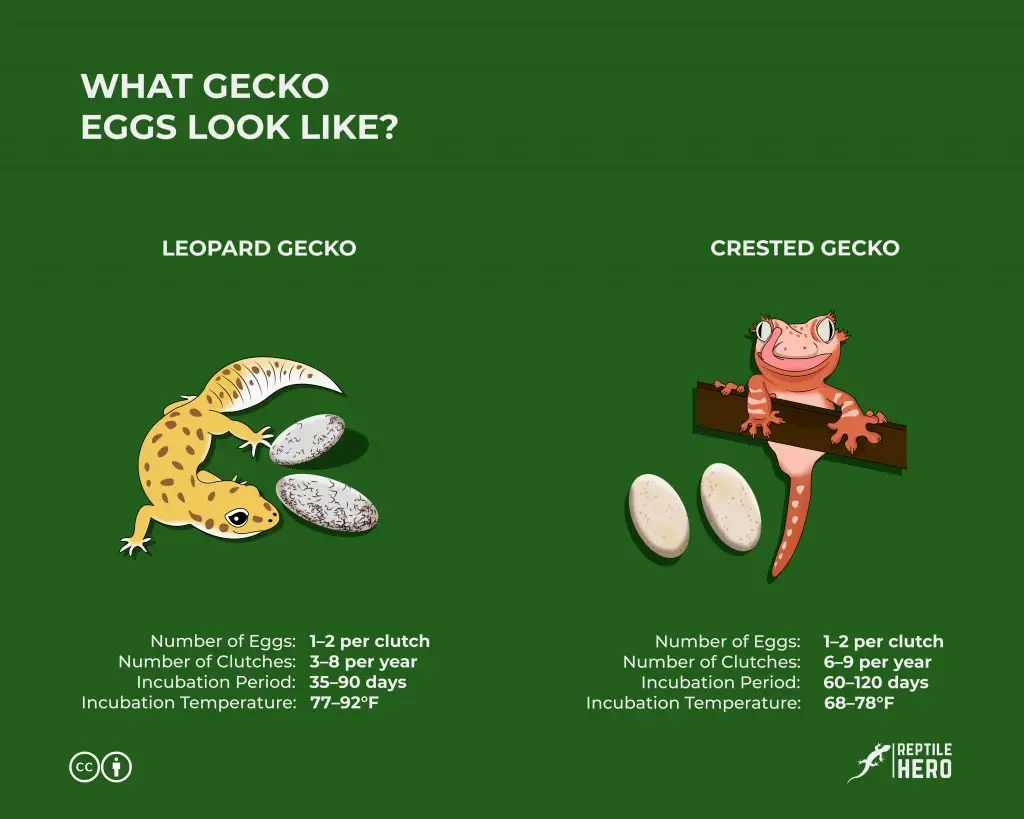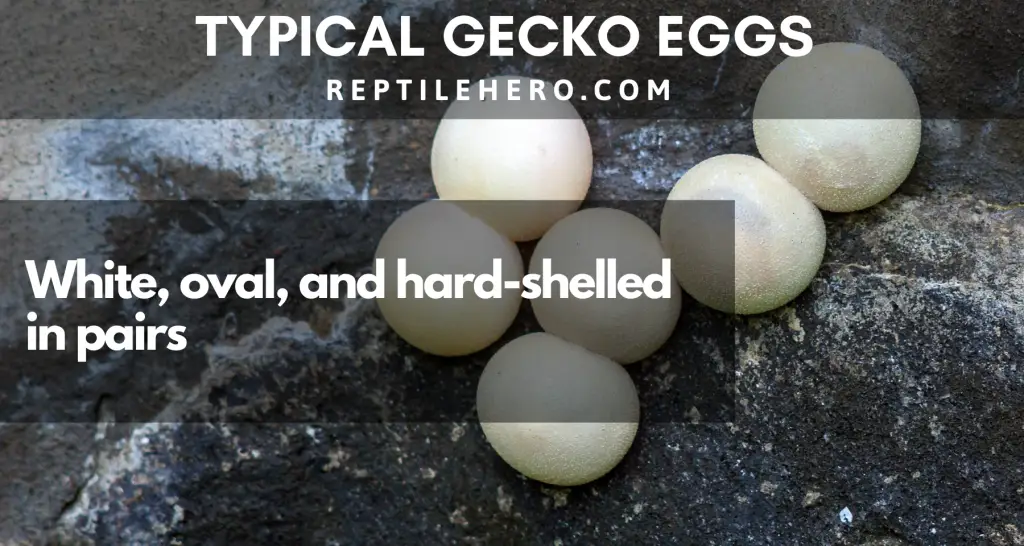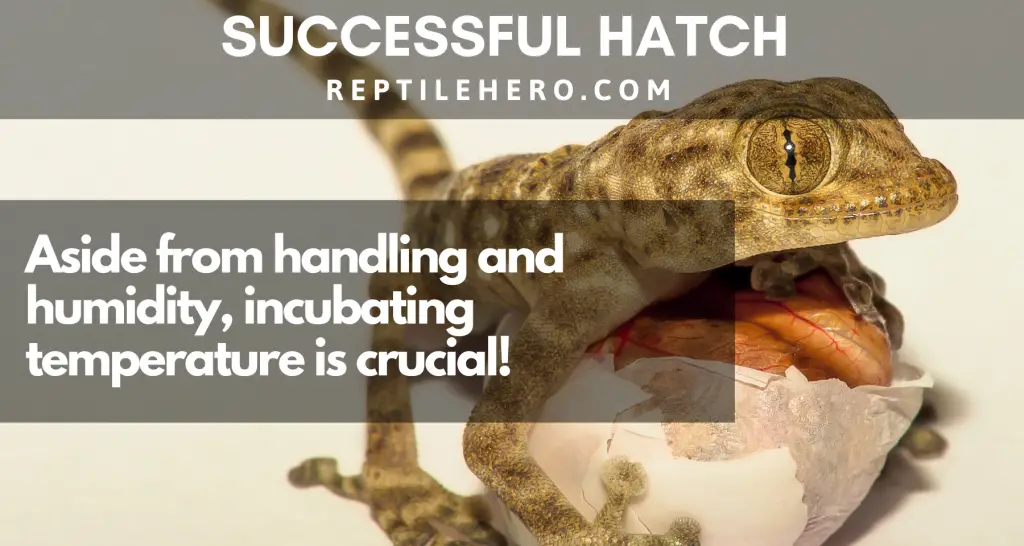What Do Gecko Eggs Look Like? [Size, Color, and More]
Whether you are aware or not, some gecko species naturally reproduce when you house a male and a female together in one enclosure. One day, you might be unknowingly greeted with an oval thing or two in the tank. Fret not, as your geckos may have just laid eggs to surprise you.
Different gecko species generally lay two white eggs—round or oval in shape. The size ranges from one-eighth to one and a half inches, laid in two to nine clutches. The hard and highly calcified eggs are either smooth or rough to the touch. Below are the main features of gecko eggs by species:
| Gecko Species | Number of Eggs | Number of Clutches | Egg Size (inches) |
|---|---|---|---|
| Leopard Gecko | 1 – 2 | 3 – 8 | 1 – 1½ |
| Crested Gecko | 1 – 2 | 6 – 9 | 1 |
| African Fat-Tailed Gecko | 1 – 3 | 3 – 5 | 1 – 1½ |
| Asian House Gecko | 1 – 2 | 3 – 4 | ⅓ |
| Chahoua Gecko | 1 – 2 | 3 – 5 | 1 – 1½ |
| Chinese Cave Gecko | 2 | 2 – 6 | 1½ |
| Electric Blue Gecko | 1 – 2 | 3 – 6 | ⅓ |
| Flying Gecko | 1 – 2 | 3 – 4 | ½ |
| Frog-Eyed Gecko | 2 | 2 – 4 | ½ – ¾ |
| Gargoyle Gecko | 1 – 2 | 4 – 9 | 1 – 1½ |
| Gold Dust Day Gecko | 1 – 2 | 3 – 5 | ¼ |
| Golden Gecko | 1 – 2 | 3 – 6 | ⅓ – ½ |
| Mediterranean House Gecko | 1 – 2 | 2 – 3 | ⅓ |
| Moorish Gecko | 1 – 2 | 2 – 4 | ¼ – ½ |
| Satanic Leaf-Tailed Gecko | 1 – 3 | 2 – 6 | 1 |
| Tokay Gecko | 1 – 2 | 3 – 4 | ⅛ – 1½ |
| White-Lined Gecko | 1 – 2 | 4 – 8 | ¼ |
| Yellow-Headed Day Gecko | 2 | 2 – 3 | ¼ |
To verify whether you have eggs or not, stay with us to know more about different gecko eggs.
What Gecko Eggs Look Like?

Depending on which species you have, the characteristics of gecko eggs are highly varied. Hence, no single description fits all.
Although they are typically white and highly calcified, the eggs may be either spherical or oval, initially somewhat soft, that hardens overtime after being laid. Some eggs are also known to grow in size throughout the incubation. On the other hand, others may produce droplets of water outside the shell as if sweating. Others unusually dent prior to hatching.
The eggs usually span between one-third and a half inches in size, where their weights are not commonly recorded. Some may feature smooth and pearly shells, especially those that are affixed on fixtures. Meanwhile, others may be relatively rough and textured, typical to the buried ones.
Incubating gecko eggs could be different from other reptiles like snakes and turtles but very different from birds. Each gecko species has its particular incubating needs. Thus, if you want to have a successful hatch, you should know the basic requirements of the egg you have.
Many factors potentially affect your egg’s condition. Though the list below is not a comprehensive guide tackling humidity levels and genetics, temperature requirements—along with egg handling—are swiftly discussed.
Below, we will talk about Leopard and Crested Geckos: how their eggs primarily look, how many eggs are commonly laid, and how many clutches females generally produce in a breeding season.
By the way, before continuing, a clutch refers to all laid eggs at a particular time or during a single reproductive event.
Leopard Gecko Eggs
Leopard Geckos (Eublepharis macularius) generally lay oval-shaped eggs the size of your thumb—around one to one and a half inches. The surface has a chalky white color with a leathery texture similar to a fine white suede.
However, other eggs are much darker, while some appear speckled. Owners who have observed these have not noticed any impact on the hatchling at all.
Healthy eggs are usually compact and rigid upon laying, only to get harder over time. Furthermore, holding a candle near the egg should allow you to see the developing embryo inside.
However, you should take heed of the following features:
- The eggs should not have a shriveled visage.
- The eggs should not be very soft to the touch.
- The eggs should not feel a texture similar to a water balloon.
If you noticed these characteristics on your gecko’s eggs, these might be infertile. To know more about why your gecko lays infertile eggs, you can read our previous article by clicking this link.
Number of Eggs: 1–2 per clutch
Number of Clutches: 3–8 per year
Incubation Period: 35–90 days
Incubation Temperature: 77–92°F
Crested Gecko Eggs
Crested Geckos (Correlophus ciliates) lay white oval eggs about an inch long. The females bury their eggs under the substrate. As a result, these may appear rough. It is not uncommon to find smooth ones though the eggs’ general texture does not guarantee their overall condition.
Some people suggest you provide a lay box with enough privacy so your gecko can lay in peace. However, there are instances when they still prefer using the soil. Hence you should be mindful to look for eggs around the tank.
Here is a short clip of a female caught in the act laying her eggs.
Once you find the eggs, removing these is the best since the females would just ignore these. Gently remove these without rotating any out of their original orientations. Although you can leave these inside the tank, opting for a separate container for incubation would best accommodate the eggs.
Experts and hobbyists like me have noted that incubating crested gecko eggs for more extended periods at lower temperatures could produce bigger hatchlings with a more robust body and a better crest structure—rendering better overall welfare.
Number of Eggs: 1–2 per clutch
Number of Clutches: 6–9 per year
Incubation Period: 60–120 days
Incubation Temperature: 68–78°F
16 Other Common Geckos And Their Eggs
Although Leopard and Crested Geckos are two of the most popular gecko species as breeding pets, there are 16 more gecko types pet owners usually breed that we will be discussing below.
1. African Fat-Tailed Gecko (Hemitheconyx caudicinctus)
African Fat-Tailed Geckos produce white oval eggs about one to one and one-half inches long. The females bury their slightly chalky eggs under the substrate, so you may opt to provide them with a lay box. Since they do not utilize this sometimes, you must look around the enclosure if you anticipate eggs from them.
Females typically lay two slightly sticky eggs per clutch that would firm up and rapidly become turgid. However, there are uncommon instances when only one egg or three eggs are in a clutch. Though these are atypical reports, you can guarantee healthy hatchlings by meeting proper incubating conditions.
Number of Eggs: 1–3 per clutch
Number of Clutches: 3–5 per year
Incubation Period: 40–70 days
Incubation Temperature: 82–93°F
2. Asian House Gecko (Hemidactylus frenatus)
Asian House Gecko eggs are round, which are about one-third of an inch in length. Rather than most reptiles’ somewhat soft-shelled eggs, their eggs are hard, optimized for resisting moisture loss and surviving long-distance travels.
In the wild, the eggs are commonly laid in the soil, under dead leaves and rocks. Often, these are deposited under loose bark and wall cavities or affixed to a firm surface. On the other hand, you can check under the boards, substrate, or carpets, inside the hides, or on tank walls if you have a gravid female as a pet.
Females typically lay two white hard-shelled eggs that are visible through the underside. Depending on geographical location in their natural environment, the eggs incubate between 46 to 62 days. However, owners observe a maturation period of 90 days in captivity.
Number of Eggs: 1–2 per clutch
Number of Clutches: 3–4 per year
Incubation Period: 46–90 days
Incubation Temperature: 64–84°F
3. Chahoua Gecko (Mniarogekko chahoua)
Chahoua Geckos lay two well-calcified oval eggs that are the size of your thumb. Generally, these are deposited above the substrate, under leaf litters, or behind tree barks. Shortly after laying, the female Chahouas—unlike Leopards and Cresteds—would guard the two pearly white eggs adhering to each other.
The females are the only Rhacodactylus gecko that lays highly calcified adhering eggs. As a result, you should be aware that they are more susceptible to calcium deficiency and metabolic bone disease after their second or third clutch for the year. Hence, you ought to carefully monitor for signs of calcium deficiency.
Number of Eggs: 1–2 per clutch
Number of Clutches: 3–5 per year
Incubation Period: 60–200 days
Incubation Temperature: 64–77°F
4. Chinese Cave Gecko (Goniurosaurus hainanensis)
Chinese Cave Geckos deposit white oval eggs generally buried under the substrate in an area away from the heat source. Furthermore, breeders observe that they prefer to lay the one and a half inches eggs in a humid part of the enclosure.
If there are no lay boxes, it is also not uncommon for the females to lay the hard-shelled eggs under the hides or tank accessories. Hence, you must be careful when looking for these so as not to accidentally break them.
Number of Eggs: 2 per clutch
Number of Clutches: 2–6 per year
Incubation Period: 60–90 days
Incubation Temperature: 75–84°F
5. Electric Blue Gecko (Lygodactylus williamsi)
Female Electric Blue Geckos typically lay pea-sized eggs, which are about one-third inch long. The white eggs are protected by hard shells, which are firmly affixed to a surface.
This gecko species is known to be egg-gluers, typical to geckos. When females deposit their sticky clutch, it is pressed firmly onto the surface, adhering tightly until it dries up. The eggs in the clutch cannot be safely removed without destroying them.
Unless you provide your females with a specific nesting site, they will instinctively lay the eggs on cramp spaces in the tank. Any crevices and gaps must be examined if you fail to provide a proper egg-laying site while expecting fertile eggs.
Number of Eggs: 1–2 per clutch
Number of Clutches: 3–6 per year
Incubation Period: 50–142 days
Incubation Temperature: 70–83°F
6. Flying Gecko (Gekko kuhli)
Flying Geckos are communal egg-gluers nesting their eggs on barks or leaves in the wild. Meanwhile, in captivity, you would find the females glue their white spherical eggs on the tank walls, under large cage accessories, inside the hides, or in the worst places for you.
The one-half to three-fourth inch eggs are fragile and are often broken during attempts to peel them from the deposition surface. Hence, the eggs can be left in the enclosure. However, if they are attached to removable accessories, you can opt to incubate them on a separate container without removing these from the fixture.
Number of Eggs: 1–2 per clutch
Number of Clutches: 3–4 per year
Incubation Period: 21–127 days
Incubation Temperature: 70–90°F
7. Frog-Eyed Gecko (Teratoscincus scincus)
Frog-Eyed Geckos deposit their white round eggs in the substrate. Like Leopards and Cresteds, the females leave the eggs alone unattended, so you should put these in a separate incubator to prevent the adult geckos from stomping them.
The eggs have hard calcareous shells. Though these are hard, they are fragile, so only touch the eggs when transferring without changing their orientations. Unlike the commonly observed two glued eggs, their one-half-inch eggs are separated from each other.
Number of Eggs: 2 per clutch
Number of Clutches: 2–4 per year
Incubation Period: 60–100 days
Incubation Temperature: 80–90°F
8. Gargoyle Gecko (Rhacodactylus auriculatus)
Unlike other gecko species that glue eggs on high elevations, female Gargoyle Geckos bury their white eggs under the substrate. The eggs—usually come in pairs—are soft-shelled, which you can place in a separate container upon laying to avoid predation from adult geckos.
The eggs are somewhat big and elongated ovals, approximately the size of your thumb. Hence, they are easy to locate once buried under the soil.
Number of Eggs: 1–2 per clutch
Number of Clutches: 4–9 per year
Incubation Period: 45–100 days
Incubation Temperature: 70–82°F

9. Gold Dust Day Gecko (Phelsuma laticauda)
Like any other species under Phelsuma, Gold Dust Day Geckos commonly lay one-fourth-inch-sized eggs in crevices of sansevieria leaves or inside bamboo shoots. The females are secretive, so you should not disturb them while laying eggs.
The two dry eggs adhere to each other; however, it is also not uncommon to find a single egg. Since these species are non-gluers, you would see the loose eggs not sticking to surfaces. Hence, you can remove these without damage once they have dried.
Although the eggs could be incubated where they are laid, adults may eat the hatchlings if they go unnoticed. Thus, eggs should be removed and set in a separate container while maintaining their original orientation. At temperatures near 82.4°F, the eggs would mature approximately 40–45 days.
Ideally, when you hold the eggs, you can roll them on your palm though you should not attempt to do it! If these are soft and gooey, it is almost a guarantee that the eggs are infertile.
Number of Eggs: 1–2 per clutch
Number of Clutches: 3–5 per year
Incubation Period: 35–50 days
Incubation Temperature: 75–85°F
10. Golden Gecko (Gekko ulikovskii)
Indian Golden Geckos are gecko species known to be egg-gluers. This ability means that their white—often yellowish—eggs are irremovable from the surface. In the wild, they are communal nesters, where the egg deposition site harbors 250 to 300 eggs from different females.
The oval-shaped eggs are often stuck on dishes, hides, or even the tank’s glass sides, which could have a diameter from one-third to one-half inch.
Females are often protective of their eggs. They preferentially attach the eggs in areas around the tank that they believe would be safe. Providing the necessary environment for the eggs to develop will surely hatch them without transferring them to another container.
Under any circumstances, never attempt to remove the glued eggs from the fixture. This action would almost always be detrimental for the developing embryo inside the eggs.
Number of Eggs: 1–2 per clutch
Number of Clutches: 3–6 per year
Incubation Period: 60–200 days
Incubation Temperature: 75–85°F
11. Mediterranean House Gecko (Hemidactylus turcicus)
Mediterranean Geckos typically hatch from oval eggs communally nested under tree barks, in crevices of man-made structures, between rock clefts, or in moist soil. Female geckos lay two or three clutches per year, consisting of one to two white eggs per clutch. The eggs are about one-third inch long and are initially soft-textured and sticky but would harden quickly.
Under normal conditions in the wild, the eggs mature between 60 to 180 days. However, in captivity, owners who incubate the eggs at temperatures somewhere near 90°F observe as short as 45 days of maturation. Meanwhile, those who incubate the eggs at lower temperatures near 79°F report as long as 60 days before the eggs hatch.
Number of Eggs: 1–2 per clutch
Number of Clutches: 2–3 per year
Incubation Period: 45–180 days
Incubation Temperature: 79–90°F
12. Moorish Gecko (Tarentola mauritanica)
Moorish Geckos have unusually almost-spherical eggs in pairs, uncommonly as a solo, per clutch. In the wild, the one-fourth to one-half inch eggs can be deposited in crevices like tree barks or wall gaps. However, you might find yours buried in a moist section of the substrate.
The eggs are white and hard. What is unique about them is they are clearly separated from one another, unlike most gecko eggs that adhere to each other. You have to be on the look-out once the eggs hatch since this species is known to eat the hatchlings.
Number of Eggs: 1–2 per clutch
Number of Clutches: 2–4 per year
Incubation Period: 55–98 days
Incubation Temperature: 70–85°F
13. Satanic Leaf-Tailed Gecko (Uroplatus phantasticus)
Satanic Leaf-Tailed Geckos deposit their one-inch eggs in secluded places such as beneath clumps of dead leaves or under the substrate. If a hide is provided in the tank, the females may opt to lay the hard-shelled eggs in there.
Typically, the white spherical eggs come in pairs per clutch, frequently wrapped in the substrate. On rare occasions, one or three eggs are in a clutch. If you ever notice a soft and sticky egg, usually stuck on a surface, discard this as this may be unviable to hatch.
Number of Eggs: 1–3 per clutch
Number of Clutches: 2–6 per year
Incubation Period: 60–120 days
Incubation Temperature: 70–78°F
14. Tokay Gecko (Gekko gecko)
Tokay Geckos are known to produce two hard-shelled eggs, which are oval in shape. The size of the eggs varies between one-eighth inch to one and a half inches. If there is a viable vertical nesting site in your tank, she will affix these onto the surface.
What is unique about Tokay parents is that they alternately protect the eggs. The female is often observed to brood over the eggs if these require temperature regulation. Hence, these should be left inside the tank with both parents.
Here is a clip showing a parent gecko guarding its eggs.
You should remember to never attempt removing the eggs from the surface they are glued onto or to never rearrange the nesting site. Any disturbances in the enclosure and its furniture would stop the female from producing eggs until next season. Otherwise, you can do so if you do not want any more eggs from her.
Another essential matter to note is that females would eat their infertile eggs but not the fertile ones. Hence, you should not be wary if you observe this behavior.
More importantly, you should remove the male if you do not plan on having more than the second or third clutch. Otherwise, the female would carry on laying eggs, potentially depleting her mineral reserves. This could risk her having egg binding as a result of kidney failure
Number of Eggs: 1–2 per clutch
Number of Clutches: 3–4 per year
Incubation Period: 60–200 days
Incubation Temperature: 80–86°F
15. White-Lined Gecko (Gekko vittatus)
White-Lined Geckos hatch from white round eggs glued on leaf stalks. In captivity, the one-fourth-inch eggs are usually affixed on tank walls, both of which are stuck with each other.
For geckos who stick their eggs on walls like the White-Lined species, you are never to remove the eggs from where these are glued if you want a higher chance of hatching them. The eggs will incubate just fine in the tank as long as temperature and humidity conditions are consistent.
You should be aware of the parents’ habit of eating or squishing the eggs. Hence, you could use a small deli cup with small holes to cover these. However, there are instances where either of the parents would safeguard the eggs. In this case, the eggs will be OK, and you are better off leaving them undisturbed in the cage.
Number of Eggs: 1–2 per clutch
Number of Clutches: 4–8 per year
Incubation Period: 75–180 days
Incubation Temperature: 75–85°F
16. Yellow-Headed Day Gecko (Phelsuma klemmeri)
Yellow-Headed Day Geckos are unusually non-gluers, which means females do not stick the eggs to a surface. As a result, the round-oval eggs of about one-fourth of an inch in diameter are commonly found hidden in isolated places. In the wild, the usual choice is inside dry bamboo shoots.
You should note that the eggs need humidity but not moisture. One of my friends has successfully utilized an empty film canister that is 45° or 90° from the ground as a makeshift bamboo cane, firmly affixed to a wall as this species does not glue its eggs to a surface.
Number of Eggs: 2 per clutch
Number of Clutches: 2–3 per year
Incubation Period: 39–80 days
Incubation Temperature: 79–86°F

Looking For Another Topic?
If you are interested to know more about gecko eggs, here are other topics we have discussed on matters related to it.
To know more about the causes of dents on your gecko’s eggs and how to solve them, check this article. Otherwise, if you want to learn more about the reasons for mold growth on your gecko’s eggs and how to deal with them, check this one.
Takeaways
Geckos lay eggs in tranches called clutches. Each clutch can have one to three eggs depending on species and health.
Geckos can be gluers or non-gluers. This pertains to females adhering their eggs on walls or burying these under the substrate.
Geckos’ eggs are typically oval-shaped. However, some species tend to produce more spherical forms while others lean on more elongated ones.
Geckos’ eggs maturation period inversely correlates with temperature—the higher the incubation temperature, the shorter the amount of time it takes for the embryo to develop into a hatchling.

![How to Choose a Halogen Lamp for Your Leopard Gecko [In-Depth]](https://www.reptilehero.com/wp-content/uploads/2021/07/word-image.jpg)


![Why Is My Gecko’s Poop Black and White? [With Science]](https://www.reptilehero.com/wp-content/uploads/2022/03/gecko-poop-black-white-cc-768x614.jpg)
![Do Leopard Geckos Need Heat Mats? [Myth or Truth]](https://www.reptilehero.com/wp-content/uploads/2022/03/does-gecko-needs-heat-mats-cc-768x614.jpg)

